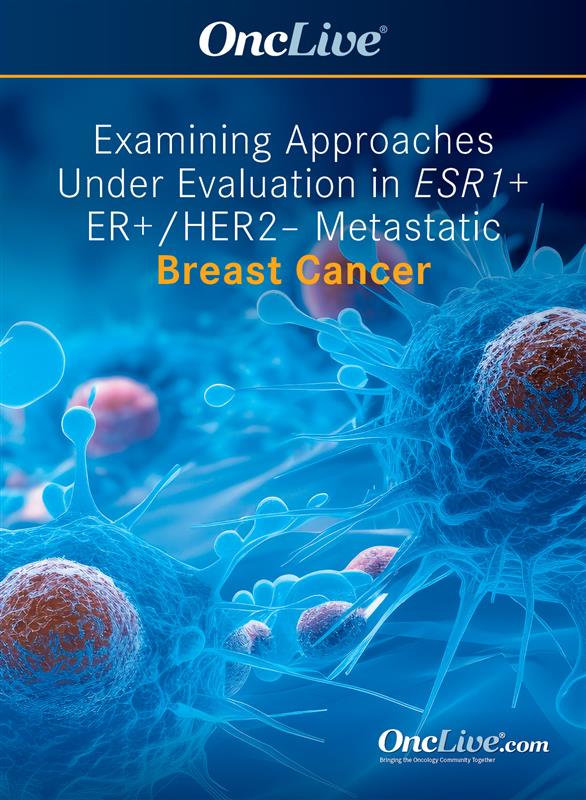News
Article
Supplements and Featured Publications
ESR1 Coalteration Treatment Resistance Does Not Impact Lasofoxifene/Abemaciclib Efficacy in ESR1+ Metastatic Breast Cancer
Author(s):
The presence of ESR1 coabnormalities, including TP53 and PIK3CA mutations, and CCND1 and FGFR1 amplification, did not demonstrate a negative impact on the efficacy with lasofoxifene and abemaciclib in patients with estrogen receptor–positive, ESR1-mutant metastatic breast cancer.
Senthil Damodaran, M

The presence of ESR1 coabnormalities, including TP53 and PIK3CA mutations, and CCND1 and FGFR1 amplification, did not demonstrate a negative impact on the efficacy with lasofoxifene and abemaciclib (Verzenio) in patients with estrogen receptor (ER)–positive, ESR1-mutant metastatic breast cancer, according to an analysis of the phase 2 ELAINE 2 study.1
Findings, which were presented during the 2023 San Antonio Breast Cancer Symposium, showed that the genomic alterations that are concurrent with ESR1 mutations are common in patients with metastatic breast cancer that has progressed on endocrine therapy and CDK4/6 inhibitors.
“While mutations in TP53 and PIK3CA and amplifications in CCND1 and FGFR1 are associated with poor prognosis and CDK4/6 inhibitor resistance, the efficacy of lasofoxifene plus abemaciclib in ELAINE 2 appeared similar in those with or without their co-occurrence with ESR1 mutations,” lead study author Senthil Damodaran, MD, of The University of Texas MD Anderson Cancer Center, and coinvestigators, wrote in the poster that was presented during the meeting.
It is common for ER-positive, HER2-negative breast cancers that undergo endocrine therapy tend to acquire ESR1 comutations, which leads to endocrine treatment resistance. Investigators noted that alterations or expression changes in RB1, FGFR1, CCND1, ERBB2, TP53, and CCNE1 are also implicated in resistance to endocrine therapy or CDK4/6 inhibitors. Therefore, there is an unmet need for effective therapeutics in this space.
The next-generation selective ER modulator and potent breast ER antagonist, lasofoxifene, has previously shown efficacy as a single agent vs fulvestrant (Faslodex) in the phase 2 ELAINE 1 trial of patients with ESR1-mutant, ER-positive, HER2-negative metastatic breast cancer who had disease progression on an aromatase inhibitor plus a CDK4/6 inhibitor2, as well as in combination with abemaciclib the phase 2 ELAINE 2 trial (NCT04432454) of patients with ESR1-mutant, ER-positive, HER2-negative metastatic breast cancer that progressed on endocrine therapy and CDK4/6 inhibitors.3
In ELAINE 2, 29 patients aged 18 years or older received oral lasofoxifene at 5 mg daily plus abemaciclib at 150 mg twice daily until disease progression, unacceptable toxicity, patient withdrawal, or death. Baseline circulating tumor (ct)DNA in genomic alterations were assessed via Guardant360 CDx.
Initial data in the overall population showed that the median PFS with the combination was 56.0 weeks (95% CI, 31.9 weeks-not estimable), a clinical benefit rate (CBR) of 65.5%, and an objective response rate of 56%.
In the analysis presented at the 2023 SABCS, investigators sought to determine the baseline genomic alterations cooccurring with ESR1 mutations in the ELAINE 2 trial, as well as therapeutic responses to the combination of lasofoxifene and abemaciclib in those who harbor these molecular alterations.
Twenty-six of the 29 enrolled patients harbored ESR1 mutations at baseline. They had previously received a CDK4/6 inhibitor (100%), fulvestrant (76.9%), a prior PI3K inhibitor (7.7%), and prior chemotherapy (46.2%). In this subset, the median PFS was 12.9 months and the CBR was 73.1%.
There were 39 gene alterations that co-occurred with baseline ESR1 mutations, which were TP53 (42.3%), PIK3CA (30.8%), CCND1 amplification (23.1%), FGFR1 amplifications (19.2%), and both CCND1 and FGFR1 amplifications (11.5%).
In the cooccurring TP53 subset, the median PFS was 8.3 months and the CBR was 64%; these outcomes were 7.8 months and 63% in those with CCND1 and FGFR1 amplifications, respectively. The median PFS was 12.9 months in those who also had a ERBB2 mutation; the CBR was 66.7%; these numbers were 11.0 months and 100% in those with a RB1 mutation.
If patients had at least 2 other genomic alterations, the median PFS was 14.7 months and the CBR was 83.3%.
The authors noted that the study limitations included its exploratory nature and the small sample size of patients; therefore, the findings should be interpreted with caution.
References
- Damodaran S, Cristofanilli MA, Goetz MP, et al. Baseline genomic alterations and the activity of lasofoxifene (LAS) plus abemaciclib (abeam) in patients with ER+/HER2- metastatic breast cancer (mBC): the ELAINE 2 study. Presented at: 2023 San Antonio Breast Cancer Symposium; December 5-9, 2023; San Antonio, TX. Abstract PO2-14-09.
- Goetz MP, Plourde P, Stover DG, et al. Open-label, randomized study of lasofoxifene (LAS) vs fulvestrant (Fulv) for women with locally advanced/metastatic ER+/HER2- breast cancer (mBC), an estrogen receptor 1 (ESR1) mutation, and disease progression on aromatase (AI) and cyclin-dependent kinase 4/6 (CDK4/6i) inhibitors. Ann Oncol. 2023;33(suppl_7):S808-S869. doi:10.1016/annonc/annonc1089
- Damodaran S, Moore HCF, Anderson IC, et al. Lasofoxifene (LAS) plus abemaciclib (Abema) for treating ESR1-mutated ER+/HER2- metastatic breast cancer (mBC) after progression on prior therapies: ELAINE 2 study update. J Clin Oncol. 2023;41(no. 16; suppl):1057-1057. doi:10.1200/JCO.2023.41.16_suppl.1057









